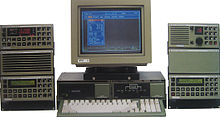User:Inmarsat C/sandbox
[1] # Numbered list item
This article needs additional citations for verification. (September 2012) |

Inmarsat-C is a two-way, packet data service operated by the telecommunications company Inmarsat which operates between mobile earth stations (MES) and land earth stations (LES). It became fully operational after a period of pre-operational trials in January 1991. The advantages of Inmarsat-C compared to Inmarsat-A are low cost, smaller and uses a smaller omni-directional antenna. The disavantages is that voice communication is not possible with Inmarsat-C. [2] The service is approved for use under the Global Maritime Distress and Safety System (GMDSS), meets the requirements for Ship Security Alert Systems (SSAS) defined by the International Maritime Organization (IMO) and is the most widely used service in fishing Vessel Monitoring Systems (VMS).
The service works with a store-and-forward method which enables interface with data network transfer including; e-mail; SMS; telex; remote monitoring; tracking (position reporting); chart and weather updates; maritime safety information (MSI); maritime security; GMDSS; and SafetyNET and FleetNET services; two-way messaging; data reporting and polling; Safety/Emergency alerting.
The service is operated via an Inmarsat-C Transceiver or a lower-power mini-C Transceiver. Both offering and approved for the same service. Data transfers between MES and LES at a rate of 600 bits/second. The frequencies for transmitting (TX) are 1626.5MHz -1645.5MHz and for receiving (RX) are 1530.0MHz - 1545.0MHz.
The service is available for maritime, land mobile and aeronautical use.
This system was also used to track the BBC's project "The Box".[3] BBC News followed a container around the world for a year to tell stories of globalization and the world economy.
The headquarters for Inmarsat C is located in London. The four Ocean Regions that are covered by inmarsat C are the Atlantic Ocean Region East (AOR-E), Atlantic Ocean Region West (AOR-W), Pacific Ocean Region (POR), and Indian Ocean Region (IOR). Within each ocean region, there is approximately 4 or 5 Maritime Rescue Co-ordination Centers (MRCC). There are approximately 22 MRCC's in the world and each MRCC station contributes to a certain MRCC area. The MRCC stations are located in: Auckland (new Zealand)-POR, Aussaguel (France)-IOR/AOR-E/AOR-W, Beijing (China)-IOR/POR, Burum (The Netherlands)-AOR-E/AOR-W/IOR, Elk (Norway)-AOR-E/AOR-W/IOR, Emeq Haela (Israel)-AOR-E/IOR, Fucino (Italy) AOR-E/IOR, Ex Goonhilly @ Burum (Netherlands), Hai Phong (Vietnam)-IOR/POR, Kumsan (S. Korea) IOR/POR, Lakhadaria (Algeria) AOR-E, Nakhodka (Russia)-POR, Nudol (Russian Fed.)-AOR-E/IOR, Perth (Australia)-IOR/POR, Psary (Poland)-AOR-E/IOR, Pune (India)-IOR, Santa Paula (USA)-POR, Sentosa (Singapore)-IOR/POR, Southbury (USA)-AOR-E/AOR-W, Tangua (Brazil)-AOR-E, Thermopylae (Greece)-AOR-E, Yamaguchi (Japan)-IOR/POR.
How to send a distress alert
[edit]When in a distress situation, your Mobile Earth Station is used to send out a distress alert. This distree alert is sent through a Land Earth Station, redirected to a land based Rescue Co-ordination Center (RCC). This will provide you with a communications link with yourself the RCC and Search and Rescue.
Method 1 Using the distrees menu on your GMDSS, follow these steps:
- Enter your vessel's position, course, speed, and any other vital information onto the form displayed on the screen.
- Choose "Nature of Distress" from the toolbar list on top of the screen.
- Choose the closest LES to your ship's coordinates near your Ocean Region. You may select any LES within your particular Ocean Region.
- Using the distress button, send the alert by keeping it pressed for the required time (5 seconds).You should receive an acknowledgment from the LES within 5 minutes.
- If no aacknowledgment from the LES, send another distress alert.
- After acknowledgment, further detailed information regarding the distress may be sent using the same method as above. This should be sent through the same LES as the original distress alert, this information will be sent to the same Rescue Co-ordination Center.
Method 2 There is usually little time to send a distress alert using the method above, therefore there is a quicker and simpler method:
- Press and hold the distress button for the required time (5 seconds).
References
[edit]- ^ "Inmarsat".
- ^ Tetley, Laurie (1994). Understanding GMDSS. Great Britain: British Library Cataloguing in Publication Data. pp. 178–179. ISBN 0-340-61042-5.
{{cite book}}: Unknown parameter|coauthors=ignored (|author=suggested) (help) - ^ Q&A: The Box, Talking Point, BBC News, 11 September 2008.
External links
[edit]- What is Inmarsat C?, Support, Inmarsat
- BBC News | Special Reports | The Box, 24 May 2012
- The Box: Latest location
- Inmarsat-C | The System
Category:Emergency communication Category:Maritime communication

